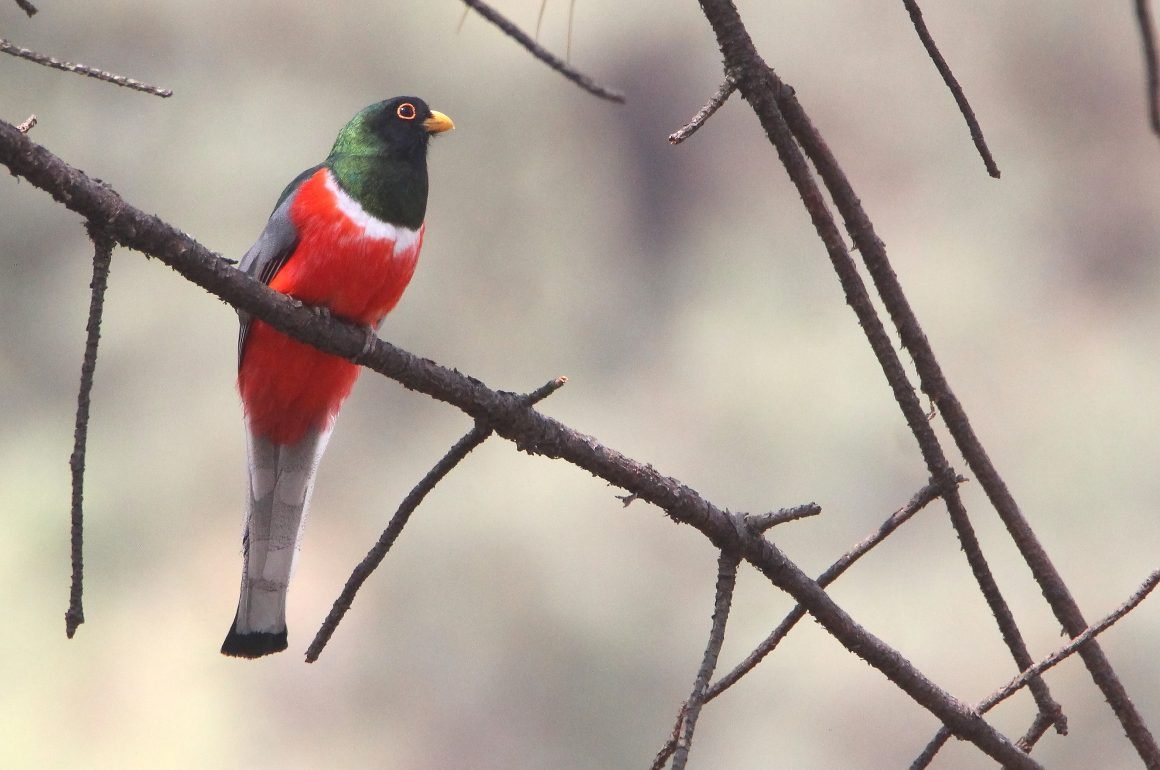
2021 is turning out to be a good year for trogons. So far, one third of my weekly outings have involved trogon sightings, with their distinctive calls being heard on a few other trips. Those are good numbers. They also remind me why I love birding in Michoacán.
The Trogon family (and order, since the order only includes one family) is quite widespread, being found in all the tropical (and some subtropical) regions of the world. Three genera occur in the New World, and four in the Old World. I would love to know how the order spread across these regions, since that spread must have involved either crossing oceans or the frigid regions that these birds avoid. It is also fascinating to see how similar Old World trogons look to their New World relatives, right down to the same flamboyant color patterns. In fact, the best known member of the family, Central America’s aptly-named Resplendent Quetzal, looks less like Michoacán’s trogons than, say, Africa’s Narina Trogon, or the Red-naped Trogon of Indonesia. (Honesty requires that I confess to having seen none of these species. Wikipedia has been used.)
Here in the highlands of central Mexico, we can see (rather easily, as I mentioned above) two trogons: the Mountain Trogon, and the Elegant Trogon. These species are visually very similar, with subtle differences in their tail patterns. Both are large, stocky birds, with a large head and long, squared-off tail. Males of both species share the odd distinction of bearing the colors of the Mexican flag, with a green head, white chest band, and bright red breast. And yet, for some reason, only the Mountain Trogon is colloquially known as the pájaro bandera, or “flag bird”.
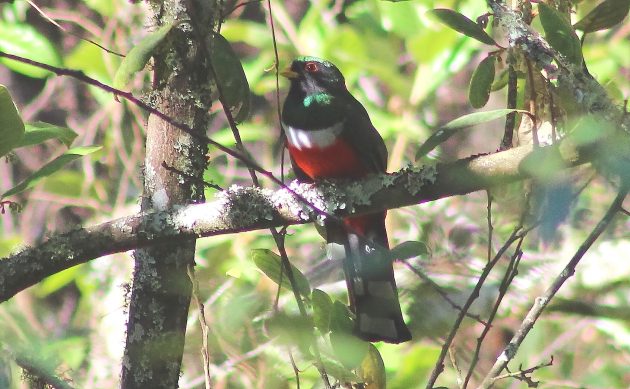
As you can tell from this shot, the green on Mountain Trogon heads is irridescent.
The male Mountain Trogon shows, along with the above colors, three bold black and white horizontal tail stripes, while the upper side of the tail is green. Male Elegant Trogons have a beautiful and intricate undertail pattern that is mostly white with fine black lines, and their uppertail is copper-colored. Females of both species are mostly coppery-brown, with red bellies. But, once again, the female Mountain Trogon shows more black on the undertail than the female Elegant Trogon.
Unfortunately, I don’t have many photos of these females, because trogons are usually rather secretive birds, and the easiest way to see one is to call in a territorial male. Don’t get me wrong; any sighting of a male trogon is a thrill! I just want to explain why I don’t have many photos to show of the females.
Any time I bird in moist highland forests, with lots of pines and other conifers, I am likely to hear the calls of male Mountain Trogons. True to its name, this bird is common, if not numerous, up to an altitude of at least 3,000 m (10,000 feet) here. And no playback is required, as it readily investigates my whistled version of its call: I whistle short, flat bursts while mouthing “tyoo, tyoo, tyoo, tyoo…”. (About the question of calling in territorial birds, I know this is considered a very bad habit in heavily birded areas of North America. But I suspect that my citizen-science monitoring outweighs any damage done with this practice here, especially since I am the only one birding most of my sites, and can only visit each one for a few hours every two or three months. So I go ahead and whistle.)
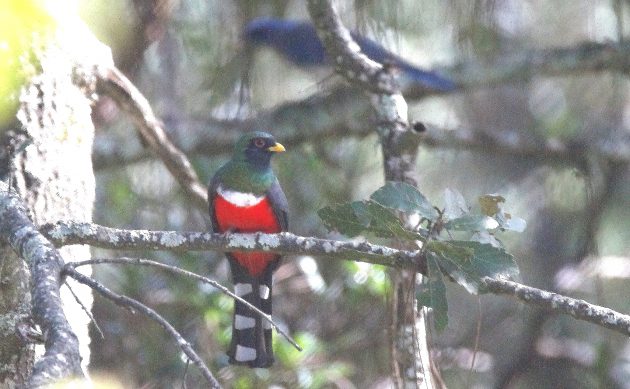
Here is a basic photo of the male Mountain Trogon. That’s a Transvolcanic Jay in the background, out of focus.
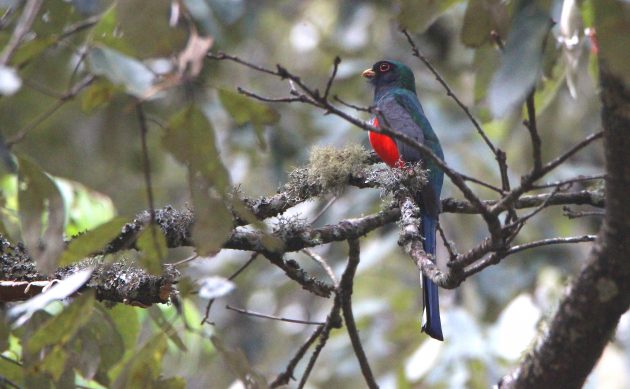
Mountain Trogon uppertails may look green, or just dark, depending on the lighting. With trogons, the light is almost always low.
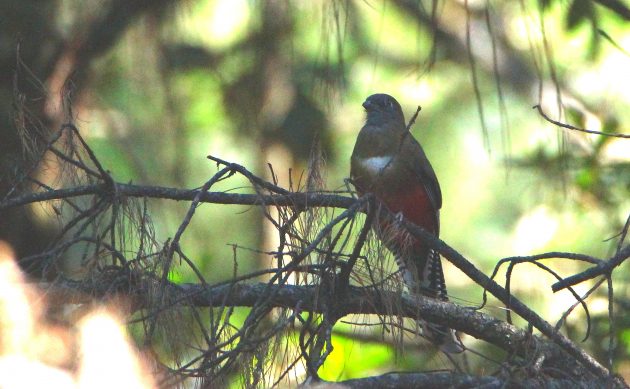
This dreadful photo was taken in deep shade, and is heavily edited. But it does show the distinctive, more complex tail pattern of immature male Mountain Trogons.
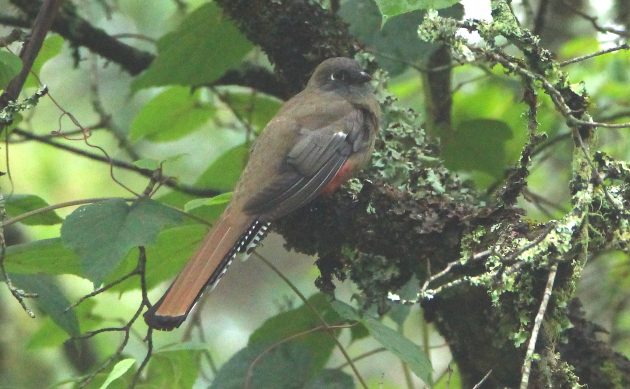
And here is my one decent photo of a female Mountain Trogon. If this one were Elegant, that white of the eyering would extend in an arc down toward the neck.
The Elegant Trogon prefers drier habitats, with a predominance of oaks rather than conifers, and in my experience is much harder to find. It has an odd call that sounds vaguely like a barking dog, which I cannot imitate. Its comparative scarcity is my motivation for this post, since a couple of weeks ago I finally achieved my first good photos of a beautiful male Elegant Trogon, and I never miss a chance to show off my serendipitous successes.
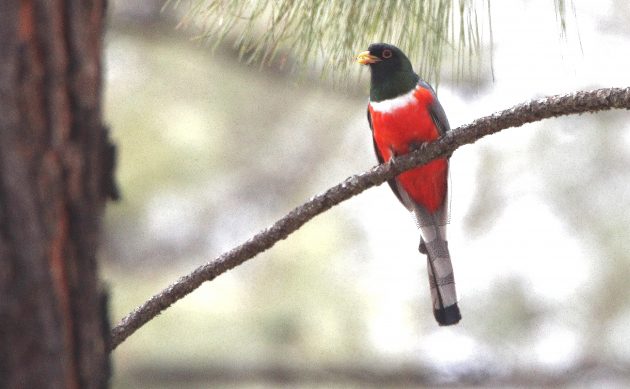
It’s all in the tail.
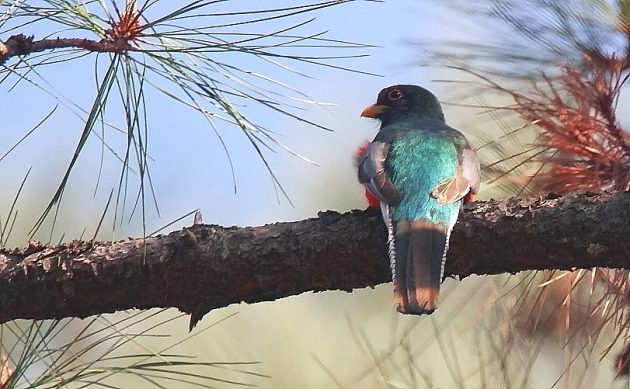
Here is the coppery uppertail that distinguishes the male Elegant Trogon.
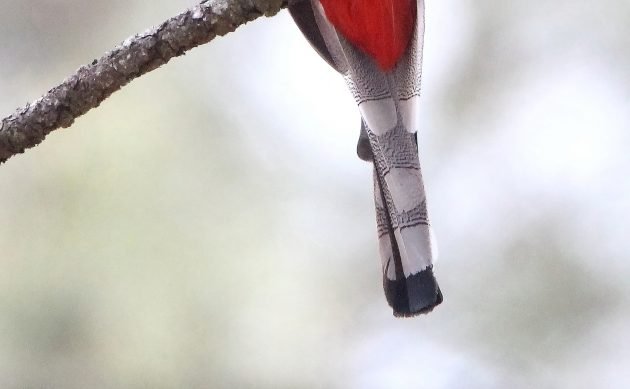
I was blown away by the pattern on this Elegant Trogon’s undertail. Someone should make a textile with this pattern.
Coastal Michoacán offers a third trogon species, the black, white, yellow and green Citreoline Trogon. But I have not birded that region yet (and, unless the crime situation improves radically, perhaps never will), so I have yet to meet this species.
In theory, the Elegant Trogon can be seen in southeastern Arizona, as is the case for so many Mexican species. But it is probably just as easy for most of you to travel to central Mexico, where the Mountain Trogon and so many other beautiful birds are much more common. So you might want to fly south, if you choose to get your trogon on. Which you should.













Leave a Comment